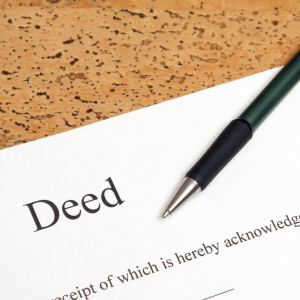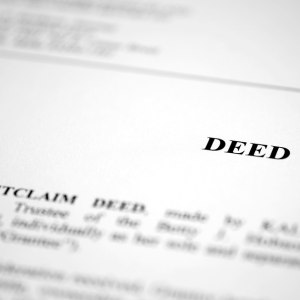
Understanding The Purpose Of A Quit Claim Deed
A quit claim deed is a legal document transferring property ownership from one person to another. This type of deed can be a useful tool for Texas homeowners who want to transfer their property rights quickly and easily.
Before executing a quit claim deed, it’s essential to understand its purpose. This type of deed is typically used when the title’s validity is not guaranteed or when there are potential issues with the property’s ownership.
It enables the current owner, known as the grantor, to transfer any interest in the property to the new owner, known as the grantee. They will not be held liable if any unforeseen issues arise with the title or previous owners.
Understanding the purpose of a quit claim deed allows homeowners in Texas to make informed decisions about using it.
The Basics Of A Quit Claim Deed In Texas

The transfer of real estate ownership in Texas is typically effected through a quit claim deed. You should familiarize yourself with this deed type’s fundamentals before executing one for your home in Texas.
The most important thing to remember is that a quit claim deed does not attest to the quality of the transferred property in any way. This deed transfers full responsibility for the property to the buyer.
Another advantage of a quit claim deed is that it speeds up the property transfer process and eliminates the need for a title search and insurance. It is still wise to have a lawyer review the paperwork before you sign it to ensure everything is correct.
If you are familiar with these fundamentals, you can easily execute a quit claim deed for your Texas property.
What You Need To Know Before Starting The Quit Claim Deed Process
Before executing a quit claim deed for your Texas home, it’s important to understand the key factors. First and foremost, a quit claim deed is a legal document that transfers ownership or interest in a property.
Furthermore, it is critical to be aware of the potential risks and benefits of this type of deed and any state-specific laws and regulations that may affect the transaction. Understanding the parties involved, including grantors and grantees, and their roles is crucial for successful execution.
To avoid future complications, ensure accurate and timely completion of all necessary documentation and paperwork. Knowing these key elements allows you to confidently navigate the quit claim deed process and ensure a smooth transfer of ownership for your Texas home.
Exploring The Benefits And Limitations Of Using A Quit Claim Deed For Property Transfer

A Quit Claim Deed is a legal document that changes who owns a piece of property from one person to another. In Texas, this kind of deed can quickly and easily change who owns a property without the hassle of a title search and insurance.
One of the best things about a quit claim deed is its easy and quick use. This makes it a popular choice for moving property between family members or when the parties already have trust. It’s important to remember that a quit claim deed doesn’t mean you automatically own the property, and it might not work in all situations.
For instance, it might not protect the property from possible liens or encumbrances. Before deciding if a quit claim deed is the best way to transfer your property, you should carefully consider the restrictions.
How To Determine If A Quit Claim Deed Is Right For Your Situation
A Quit Claim Deed is a useful tool for transferring property ownership in Texas, but it’s important to consider its suitability for your specific situation carefully. One way to determine this is to examine the relationships between the parties involved.
A quit claim deed may be an option if the grantor and grantee have complete trust and agreement. Furthermore, it may simplify the transfer process if there are no outstanding liens or mortgages on the property.
If you are concerned about future title issues or disputes, consider a warranty deed. Consulting with a real estate attorney can also help you determine whether a quit claim deed suits your situation.
Required Documents And Information For Executing A Successful Quit Claim Deed

Your Texas home must have certain paperwork and information to successfully execute a quit claim deed. A property’s original deed is the first and most important document since it establishes ownership.
A passport, driver’s license, or another valid form of identification will also be required for this purpose. Legal descriptions of property, which can be found on the original deed or in a survey, are also essential.
For this to be approved, proof of paid-off or released mortgages or liens on the property must be provided. The recipient’s name and contact information must also be included in the quit claim deed for the property to be properly transferred.
All parties involved in executing the quit claim deed for your Texas home should have the following documents and information on hand to guarantee a smooth and successful process.
Protecting Your Interests Through Properly Drafting And Recording Your Quit Claim Deed
Protecting your interests is crucial when executing a successful quit-claim deed for your Texas home. Properly drafting and recording your quit-claim deed can accomplish this.
By carefully crafting the language and terms of the deed, you can ensure that all parties involved understand their rights and responsibilities. Furthermore, recording the deed with the county clerk’s office creates an official record of the transfer, providing you with legal protection in future disputes or challenges.
To protect your interests in this legal document, pay close attention to every detail and seek professional assistance if necessary.
Understanding The Role Of Notarization In The Execution Of A Quit Claim Deed

Notarization is crucial for a successful quit claim deed for your Texas home. This legal procedure necessitates the presence of a notary public who acts as an impartial witness to the document’s signing by all parties involved.
The notary ensures that all signatures are genuine and that each party enters the agreement voluntarily and without coercion or pressure. Notarization also verifies the identities of all signers, which aids in preventing future fraud or disputes.
Notarization is required in Texas for all quit claim deeds to be considered valid and enforceable, making it a necessary step in the property ownership transfer process.
Potential Tax Implications To Consider When Using A Quit Claim Deed For Property Transfer
When using a quit claim deed to transfer property ownership in Texas, it’s important to consider the tax implications. While this type of deed may appear to be a simple way to transfer property, it is critical to consider the potential tax consequences.
For example, if the property being transferred has an outstanding mortgage, the grantor may still be required to pay taxes on the remaining balance. Furthermore, capital gains taxes may apply depending on the value of the transferred property and any capital gains realized since its purchase.
Before executing a quit claim deed, consult a tax professional to understand and fully prepare for any potential tax implications.
Exploring Alternative Options To Consider Instead Of Using A Quit Claim Deed

When transferring ownership of your Texas home, a quit claim deed may appear to be the most straightforward option. However, before going this route, you should consider other options that better suit your needs.
A warranty deed, for example, provides additional protection to the buyer while ensuring the seller has clear ownership of the property. Another option is a special warranty deed, which guarantees that no liens or debts have been incurred on the property during the seller’s ownership.
Furthermore, a gift deed may be a better option if you want to transfer ownership to a family member or loved one. By considering these alternative options, you can ensure that your property transfer goes smoothly and with few complications in the future.
Tips For Successfully Negotiating Terms And Conditions In A Quit Claim Deed Agreement
To successfully execute a quit claim deed for your Texas home, it is essential to negotiate the terms and conditions of the agreement. Following these guidelines will help make the negotiation process go more smoothly and fairly.
You should start by investigating the property’s title and any possible liens or encumbrances to prepare you for negotiations. Accurately determining a fair price also requires knowledge of the property’s worth and similar properties in the neighborhood.
A real estate attorney is a good choice if you want someone to help you through the negotiations and watch out for your best interests. The best way to avoid misunderstandings and disputes is to communicate clearly and openly with everyone involved.
Lastly, be bold in negotiating and standing up for what you need, but be flexible enough to compromise if it means reaching an agreement that benefits both parties. This article will provide the information you need to negotiate the terms and conditions of a quit claim deed agreement for your home in Texas.
Ensuring Compliance With State Laws And Regulations When Filing A Quit Claim Deed In Texas

When filing a quit claim deed for your Texas home, following all applicable state laws and regulations is critical. Texas has specific requirements for the quit claim deed to be valid and legally binding.
This includes properly executing the document, notarizing it, and recording it at the county clerk’s office. Failure to comply with these laws and regulations may invalidate the deed, resulting in future legal issues.
Additional local ordinances or regulations may also be considered when filing a quit claim deed in certain areas of Texas. To ensure that a quit claim deed is executed successfully, extensive research and understanding of all applicable laws and regulations are critical.
How To Avoid Common Pitfalls And Mistakes When Completing A Quit Claim Deed On A House
You should avoid certain traps and errors when executing a quit claim deed for your Texas home. A typical error is failing to thoroughly investigate the property’s title history before signing the deed.
In the future, this could cause problems and legal troubles due to unforeseen claims or liens on the property. The requirement that all parties sign the deed in the presence of a notary public is a legal requirement in Texas, but some may overlook this.
Doing otherwise might invalidate the deed. You should also be careful not to rush through the process without completely grasping the consequences of transferring ownership.
Take the time to read the deed word for word and consult an expert if you feel you need to clarify anything. The execution of your quit claim deed for your Texas home can go off without a hitch if you anticipate and avoid these common mistakes.
Utilizing Professional Services Vs. DIY: Pros And Cons Of Each Approach For Executing A QCD
![how to fill out quitclaim deed in market_city]](https://image-cdn.carrot.com/uploads/sites/41477/2024/10/how-to-fill-out-quitclaim-deed.png)
When executing a quit claim deed for your Texas home, one of the most important decisions you’ll have to make is whether to hire a professional or try it yourself. Each option comes with advantages and disadvantages.
Professional services can provide peace of mind by ensuring that experienced professionals handle the legal aspects of the QCD. They can also provide advice and ensure all necessary steps are correctly taken.
However, this option may come at a higher price. On the other hand, a DIY approach can save money, but it necessitates extensive research and understanding of the legal process involved in executing a QCD.
Mistakes can be made without proper knowledge, resulting in costly consequences in the long run. Finally, when executing a successful quit claim deed for your Texas home, it is critical to carefully weigh the pros and cons before deciding which approach is best for your unique situation.
Finalizing The Process: Steps To Take After Filing Your Completed Texas Quit Claim Deed
After completing and filing your Texas quit claim deed, there are a few important steps to complete. To begin, ensure that all parties have signed and notarized the document.
This will validate the agreement and make it legally binding. It is then recommended that the deed be recorded at the county clerk’s office where the property is located.
This creates a public transfer record and protects you against future disputes. Additionally, it is critical to update your property records with the county tax assessor’s office and homeowner’s insurance policy to reflect the change in ownership.
It may also be beneficial to consult with a real estate attorney or tax professional about the tax implications of transferring ownership via a quit claim deed.
What Are The Disadvantages Of A Quit Claim Deed?
While a quit claim deed appears to be a quick and easy way to transfer ownership of a property, several drawbacks must be considered. One major disadvantage is that the grantor (the person relinquishing ownership) makes no guarantees or promises regarding the property’s title.
If there are any issues with the title in the future, the grantee (person receiving ownership) will have no legal recourse against the grantor. Furthermore, a quit claim deed offers no protection against liens or other encumbrances on the land.
This could make the grantee vulnerable to unexpected financial obligations. Furthermore, if multiple owners are listed on a quit claim deed and one wishes to sell their portion of the property, finding buyers can be difficult because they may be hesitant to take on potential title issues.
These drawbacks emphasize the importance of properly executing a quit claim deed under Texas law and seeking legal counsel before proceeding with this real estate transaction.
What Is A Quitclaim Deed Most Often Used To Do?

A quitclaim deed is a legal document that transfers ownership of a property from one person to another. In Texas, this type of deed is commonly used to transfer ownership among family members, such as parents and children, or between divorcing couples.
It can also be used to correct errors in the title or add or remove someone’s name. However, it should be noted that a quitclaim deed makes no guarantees about ownership status or potential liens on the property.
Before proceeding with a quitclaim deed, both parties involved must thoroughly understand the implications and consult a legal professional. Understanding the purpose and limitations of a quitclaim deed will help ensure that this document is executed smoothly for your Texas home.
How To Transfer Ownership Of House In Texas?
If you are a Texas homeowner looking to transfer ownership of your home, signing a quit claim deed is one option to consider. This legal document allows you to transfer your property interest to another party without making any warranties or guarantees.
To successfully execute a quit claim deed for your Texas home, you must first understand the process and then follow all of the steps. This includes getting a valid form from the county clerk’s office, filling it out correctly with accurate information, and having it notarized.
Ensuring that all relevant parties to the transfer are present and willing to sign the document is also critical. By following these steps and, if necessary, seeking the assistance of a real estate attorney, you can learn how to execute a successful quit claim deed for your Texas home and seamlessly transfer ownership.
How To Remove A Name From House Title In Texas?
If you want to remove your name from a Texas house title, one of the most effective and efficient ways is to use a quit claim deed.
This legal document authorizes the transfer of ownership rights from one party to another and can be used to remove a person’s name from a property title.
However, executing a successful quit claim deed requires meticulous attention to detail and knowledge of Texas’ laws and requirements.
Following these steps and consulting with a reputable real estate attorney, you can learn how to successfully remove your name from a Texas home title using a quit claim deed.
These details apply to all of Texas, including cities like Houston, Irving, Dallas, Arlington, and Fort Worth, as well as their surrounding areas. For additional assistance or specific inquiries, call us at (800) 467-0003. Visit our website, Sell My House Fast Now, for more information and a full description of our services.
Resources To Help You Sell A House In Texas
| [ | |||||
| “ | ] | “ | ] |


